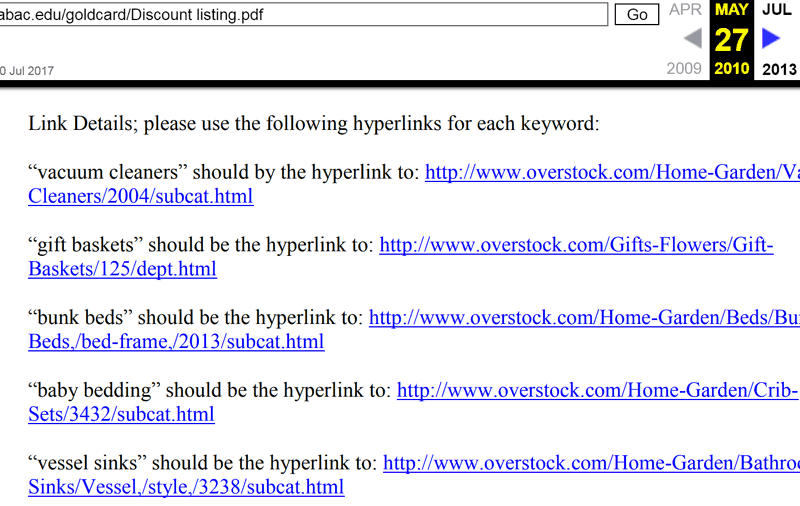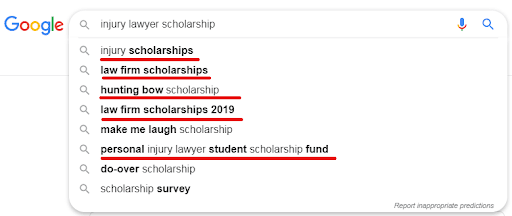Google has been improving its ability to identify manipulative links for decades in response to aggressive search marketers who keep inventing new ways to manufacture links.
In simple terms, search algorithms divide links into two kinds:
- Normal (natural) links
- Unnatural links
Unnatural links are essentially spam, and normal links are everything else.
The goal for Google is to ignore unnatural links and only count the natural links and use those for ranking purposes.
The problem for businesses is those old tactics that Google is aware of keep coming back with new names.
When that happens, spammy techniques that should be avoided gain popularity, and Google is already there to devalue them all over again.
About Signals Of Link Spam
When talking about signals that indicate a site might be engaging in a manipulative link-building practice, it’s important to understand that statistical analysis of this kind isn’t looking at just one signal in isolation.
Looking at single signals can result in false positives, where an innocent site is mistakenly identified as unnatural.
The statistical analysis becomes more accurate when groups of signals are looked at together.
So, while this article may refer to specific signals (if they are used), they are likely used in combination with other signals to achieve a higher accuracy rate.
Additionally, Google also uses AI to weed out manipulative links.
1. Adding Links To Existing Webpages
Unless Google confirms it, we can’t say definitively that something described in a patent is in use by Google.
Considering that, it’s useful to consider a 2003 patent called Information Retrieval Based on Historical Data.
The patent describes tracking website changes that may indicate spammy activity.
One signal in particular that it tracks is the addition of links to existing webpages.
If most sites that add links to pre-existing webpages are sites that are selling links, it becomes easier to spot those and remove them from the link graph.
Other factors the patent suggested were useful to track:
- How many links are added.
- How often links are added.
- How often links are removed.
- How fast links are acquired.
- How often the content is updated.
We cannot know for certain if Google searches for unnatural links based on time-related factors of links and content.
We only know Google thought of this in 2003, and almost twenty years later, Google could easily make this a part of its spam-fighting AI.
The importance of the patent is that it’s possible that Google could detect paid links by monitoring the inbound/outbound link changes within a domain over time.
Circling back to the point of this section, adding links to existing pages is a strategy that Google can likely catch and devalue.
2. EDU Discount Link Building
This is a form of link building where a link builder or the business itself offers university students discounts on products in exchange for a link from a university webpage.
This is a form of link building that Google has been onto for over a decade.
For example, Overstock.com was reported to be penalized by Google in 2011 for this specific form of sketchy link building.

Overstock.com or someone working for them offered university discounts in exchange for links to their product pages.
Unfortunately for Overstock.com, the document apparently contained the text of the outreach with instructions for how to link to the Overstock.com product pages.
The original PDF doesn’t exist anymore, but Archive.org has a snapshot of it here where it does exist. The importance of those instructions is that they showed that the links were not natural.
As you can see from the link to the WebmasterWorld discussion about the incident, this tactic violates Google’s guidelines; if that matters to you, then don’t do it.
3. Free Products Link Building
Offering free products in exchange for a link is a variation of the paid link scheme.
The interesting thing about this tactic is that it can actually be illegal because it may violate the United States Federal Trade Commission (FTC) rules against publishing reviews or recommendations that have been paid for with products, samples, or other compensation.
The official guidelines are here: FTC – Guides Concerning the Use of Endorsements and Testimonials in Advertising.
An easy-to-read FAQ about endorsements is here: FTC – Endorsement Guides: What People Are Asking.
Offering free products in exchange for links may be illegal and violate Google’s guidelines.
4. Brand Mention Links
This linking scheme involves hiring a writer to insert links into an article that is published on a third-party website.
The writer receives payment from the company that hired the content writer. The writer is also secretly paid to insert a link by another company, essentially getting paid twice for one article.
These kinds of article links do not typically disclose that a payment was made to the writer for the link, which may violate the FTC Guidelines cited above.
A relevant section is here:
“Your spokesperson should disclose her connection when promoting your products outside of traditional advertising media (in other words, on programming that consumers won’t recognize as paid advertising). The same guidance also would apply to comments by the expert in her blog or on her website.”
The following FTC guideline states that if the advertisement cannot be disclosed (as in a hidden arrangement), then that advertisement should not exist.
“If a disclosure is necessary to prevent an advertisement from being deceptive, unfair, or otherwise violative of a Commission rule, and it is not possible to make the disclosure clearly and conspicuously, then that ad should not be disseminated. This means that if a particular platform does not provide an opportunity to make clear and conspicuous disclosures, then that platform should not be used to disseminate advertisements that require disclosures.”
Paying a content writer for links in articles is a link scheme, and it could result in a manual action if Google can spot it.
There have been instances where this practice has been exposed in news articles, which could become a reputation management headache.
5. Link Bait Campaigns
What is Link Bait Link Building?
Link baiting is an old tactic created in the late aughts to get links from the seemingly countless thousands of people who were blogging at the time.
The tactic is based on the idea of creating content that others will find interesting than getting it amplified on popular websites, which in turn would cause other sites to link to the original content.
How Link Bait Campaigns Can Be Useful
Typical forms of link bait that can work are Ego Bait and Resource Bait.
- Ego bait is when the site interviews a popular person.
- Resource Bait is when the site publishes an exhaustive resource on a given topic.
For more information, see Todd Malicoat’s 2007 essay on link bait.
Link baiting can result in hundreds or thousands of relevant links if it’s done in a way that exposes the site to relevant sites and potential customers.
And that way of link baiting with relevance fits into Google’s recommendations:
“The best way to get other sites to create high-quality, relevant links to yours is to create unique, relevant content that can naturally gain popularity in the Internet community. “
How Link Bait Campaigns Fail
Link bait campaigns can fail because the easier ways of doing it are generally off-topic to the core of what the business does.
That results in irrelevant links.
Easy link bait campaigns involve contests, humor, and stunts.
An example is an anecdote of a real estate company that ran the world’s worst real estate agent photo contest.
For years afterward, the real estate site was relevant for search queries like the world’s worst real estate agent.
Another example is the experience someone shared at one of my search conference presentations several years ago.
An audience member related how his wildly successful link bait campaign attracted thousands of links but failed to increase rankings and sales.
Their PR stunt was mentioned on a popular website called BoingBoing, and his site was mentioned and linked to newspapers and blogs worldwide, in multiple languages.
But the “success” was useless for rankings, brand awareness, and sales because that business sold hardware to government defense agencies and university science departments.
6. Sponsor Links
A sponsor link is a form of link buying where one finds an organization that accepts donations, and in return, the organization links to the donors.
This kind of link building has existed for a long time.
This tactic was popular circa 2006, but it has gone stale and stopped working not long after that date.
Not only does it not work, but if you do it enough times, it could result in a manual action.
And if that’s not good enough for you, here’s what Google’s John Mueller said about charity sponsorship links in a Webmaster hangout:
“…if with your website you’re sponsoring… different clubs and sites where it looks like the primary intent is to get a link there, then that’s something the web spam team might take action on.
…So I’d try to take a look at the bigger picture there and consider whether or not this is really something that you’re doing systematically; like going out and sponsoring other sites or products with the intent of getting a link or if this is something that’s essentially just a natural part of the web.”
Sponsorship of organizations that are popular with potential clients provides a great way of building connections with those customers.
Displaying a badge of membership in or support of an organization communicates that the ideals of the business match those of the client. This can increase goodwill and trust between the customers and the business.
Sponsorship links can also be good for a business but only when they’re accompanied by a nofollow attribute.
7. Scholarship Links
PageRank and link ranking algorithms look at how the web interconnects.
Google builds a map of the internet and then likely creates what’s called a Reduced Link Graph, consisting of mostly non-spam links and pages.
Then, as part of the ranking analysis, it organizes the web into neighborhoods by topic.
Scholarship links are great if your goal is to rank for [keyword phrase] + scholarship.
The problem with these kinds of links is that they have an irrelevant context.
Most sites that do scholarship link building aren’t about scholarships. They’re about things like personal injury lawyers.
 Screenshot from search for [injury lawyer scholarship], Google; modified by author, July 2022
Screenshot from search for [injury lawyer scholarship], Google; modified by author, July 2022
There is no relevance between a link from a school to a personal injury lawyer to rank for personal injury lawyer search phrases.
The link is relevant for things like [personal injury attorneys scholarship]. Google will rank these kinds of pages for those scholarship search phrases, which is the extent of the value.
This is useless for business owners because the links aren’t about their business but scholarships.
If a personal injury lawyer attained links that are relevant for the search phrase, [pizza restaurants], they will rank for [personal injury pizza restaurant].
But a pizza restaurant link is not desirable for a personal injury lawyer website. The same kind of relevance problem applies to scholarship links.
An SEO may say that a link from a .edu will help increase the domain authority of a page – that it will increase “trust” and that .edu links are special.
That’s wrong in three different ways:
The industry was done with scholarship links years ago, but for some reason, old and outdated link-building tactics keep getting a new life in the personal injury SEO space.
Now, let’s move on to an even more useless link-building trick.
8. Badges For Links Trick
One of the oldest and out-of-date link-building tricks around is the badges link-building strategy.
The badge for links strategy is a variation of the awards strategy and widgets strategy.
The idea is to create a fake award and then award it to websites that will display your image badge to proclaim them a winner. The trick is to give them the badge and the code containing a sneaky link to your website.
Run as fast as you can from any SEO who tells you that the badges trick is a useful link-building tactic. This link-building strategy is so stale that if you breathe on it, it’ll crumble and blow away.
The badges link building technique is similar to the widgets technique, which Google explicitly called out in 2016.
It’s similar because, in both cases, the link builder is giving something of value (an award, a visitor counter) and forcing the link back to the original website.
The tactic relies on people linking to your site for reasons other than your content, which goes against Google’s recommendation of “high-quality, relevant links.”
9. Blog Comments
Blog commenting is such a bad link-building tactic that the search engines created a link attribute called “nofollow” in 2005.
It’s pointless to consider using a tactic that was burned in 2005.
Even though the “nofollow” attribute is now a hint, that’s no excuse to start comment spamming like it’s 2004.
The only people who say it works are those who sell comment spamming services.
10. Expired Domains
Buying an expired domain is an old tactic.
It’s a tactic that worked well until 2003 when Google began resetting the PageRank of expired domains.
Here’s a screenshot of a forum post from 2003 where a Googler (GoogleGuy) announces a new update that, among other things, flatlines the PageRank of expired domains.
 Screenshot of a 2003 post from WebmasterWorld SEO Forum, July 2022
Screenshot of a 2003 post from WebmasterWorld SEO Forum, July 2022
Expired domains have their PageRank reset.
When Google updated its algorithm to reset the PageRank, the Google toolbar that displayed a PageRank score showed that there was no PageRank transferring.
Seriously, redirecting an expired domain to parasite the link signals hasn’t worked since 2003.
11. Charity Link Building
This is a variation of the sponsorship link-building tactic. The problem with this tactic is that the links are irrelevant.
An SEO will try to convince you that domain authority, trust, and .edu magic will help a site rank better, but those excuses have already been documented as untrue.
12. Article Directory & Guest Posting Services
Content syndication through article directories and guest posting services are tactics where content is offered for publication through service in exchange for an active link.
There was a time when article syndication sites were popular. They were essentially directories of articles that could be copied and published as long as the links were preserved.
Some of these companies sometimes position themselves as matchmaking sites that connect “bloggers” with publishers who could request free articles in exchange for live links.
Google has in the past cracked down on sites that help promote guest blog posts.
Today we took action on a large guest blog network. A reminder about the spam risks of guest blogging: http://t.co/rc9O82fjfn
— Matt Cutts (@mattcutts) March 19, 2014
Matt Cutts (formerly the head of Google’s Webspam team) famously warned the SEO industry against scaled guest article link building:
“Ultimately, this is why we can’t have nice things in the SEO space: a trend starts out as authentic. Then more and more people pile on until only the barest trace of legitimate behavior remains.
We’ve reached the point in the downward spiral where people are hawking “guest post outsourcing” and writing articles about “how to automate guest blogging.”
So stick a fork in it: guest blogging is done; it’s just gotten too spammy.”
13. Guest Posts
While scaled guest posting clearly violates Google’s guidelines, individuals engaging in guest posting might also find that their links don’t work (at best), or their sites may acquire a manual action penalty (resulting in a loss of rankings, at worst).
Is it okay to do it on a limited basis?
There are limits that, when crossed, cause guest posting to be seen as spammy.
This is what Google says about how guest posts can be considered manipulative:
- Stuffing keyword-rich links to your site in your articles
- Having the articles published across many different sites; alternatively, having a large number of articles on a few large, different sites
- Using or hiring article writers that aren’t knowledgeable about the topics they’re writing on
- Using the same or similar content across these articles; alternatively, duplicating the full content of articles found on your own site (in which case use of rel=”canonical”, in addition to rel=”nofollow”, is advised)
Google’s article on guest posting advises that it takes action against sites it determines are publishing guest posts for links.
“For websites creating articles made for links, Google takes action on this behavior because it’s bad for the Web as a whole.”
In general, a link-building tactic is not spammy if there’s no money or consideration exchanged and if there’s no requirement of a link.
Additionally, creating advertising without disclosure is prohibited by the United States Federal Trade Commission (FTC).
14. Widget Links
Widget links are one of the oldest forms of scaled link building.
Many years ago, when this tactic worked, the top-ranked site for a certain medical condition was a lawyer site that distributed visitor counters for universities to use at the bottom of their webpage. The visitor count widget contained a link to the lawyer site.
This tactic worked for several years, and then it stopped working.
When WordPress gained popularity, many people started using other forms of useful widgets for people to add to their sites.
Plugins for things like a weather display, news, RSS feeds, and other widgets were created so that they resulted in a link back to someone’s site.
Google formally published a blog post to warn against this technique.
Widget links are one of those ideas that sound good late at night around the kitchen table but, in practice, are a fast track to a manual penalty.
15. Press Release Link Building
Press releases are useful for announcing important news about a business.
The value is in a news organization publishing a news story based on the press release.
The value is not in the links embedded in the press release.
Google may also choose to ignore the links in duplicate content because it is painfully obvious that links in duplicate content press releases do not represent the quality of being a true link signal.
Google’s John Mueller is on record stating that press release links are something Google tries to ignore.
This doesn’t mean websites shouldn’t publish press releases. Press releases are a way to get the news out about a business.
16. Profile Link Building
Forums generally create a profile for every member.
When a member publishes an answer or asks a question on a forum, their name in the forum post becomes a link that links back to that member’s profile page, which might contain a member bio and a link to their website or blog.
As the Link Building Forum moderator at WebmasterWorld and friends with many forum owners, I can tell you now that online community administrators know about link builders who sign up to a forum to drop a link from their profile.
It’s easy to spot, and many sites prevent Google from crawling member profiles and/or adding nofollow to any links contained in a member profile.
In any case, it’s a low-quality link with zero relevance.
It’s not a true link.
A forum profile link is about as useless and spammy as a link can get. There is ZERO context for a ranking signal to a webpage. It’s silly to consider such a link as a link-building tactic.
In my opinion, anyone who recommends this tactic has a credibility problem.
17. UGC & Forum Spamming Tactics
User-generated content (UGC) websites are platforms that offer the public a way to discuss topics. Examples are forums and platforms like Quora and Reddit.
Some spammers will do things like ask a question or answer a question, then add a link within their post.
One of the jobs of a moderator on these UGC platforms is to keep an eye out for forum spammers whose sole activity consists of promotional activity.
Some SEOs say that it’s a win-win to answer a question and then add a link to another site, saying, “And there’s more information at this site!”
From my nearly twenty years of experience as a forum moderator and as a publisher of a forum, I can say with confidence that many moderators will generally regard that kind of behavior as spam. It’s simply not a quality community behavior when someone shows up, posts a link, and then disappears.
A more positive approach, however, would be to simply show up and demonstrate expertise, authority, and trustworthiness as a good community member by answering questions in a helpful manner and becoming a longtime and engaged member of that community, without posting promotional links.
18. WordPress Theme Link Building
Another “sounds good around the kitchen table” idea is to create a theme and add a “powered by” link at the bottom of the theme.
A “powered by” link is a normal thing to do. It’s generally not a bad thing, but don’t expect it to help rankings.
“Powered by” links in the footer stopped working nearly 20 years ago.
In the early days of SEO, one of the top-ranked sites for keywords like Web Design (in any state) was this one business that created thousands of websites and added a keyword-rich link back to their web design site on every site they built.
It worked for a while, and then it stopped working sometime around 2003.
Takeaway
Old link-building tactics (like paid links or expired domains) go in and out of fashion. After 10 or more years, people forget that something doesn’t work, and the old tactic is new all over again.
Link-building tactics can sound good, but do some research before executing the plan because there aren’t that many new tactics; it’s possible that what seems like a good idea isn’t that good.
It’s useful to understand the history behind link-building tactics. It’s also useful to understand how search engines use links.
Knowing these tactics will help a business avoid repeating the mistakes of the past.
There’s nothing wrong with creating something useful and telling others about it. That’s totally legit and quite likely the safest form of link building.
Featured Image: Paulo Bobita/Search Engine Journal
window.addEventListener( ‘load’, function() {
setTimeout(function(){ striggerEvent( ‘load2’ ); }, 2000);
});
window.addEventListener( ‘load2’, function() {
if( sopp != ‘yes’ && addtl_consent != ‘1~’ && !ss_u ){
!function(f,b,e,v,n,t,s)
{if(f.fbq)return;n=f.fbq=function(){n.callMethod?
n.callMethod.apply(n,arguments):n.queue.push(arguments)};
if(!f._fbq)f._fbq=n;n.push=n;n.loaded=!0;n.version=’2.0′;
n.queue=[];t=b.createElement(e);t.async=!0;
t.src=v;s=b.getElementsByTagName(e)[0];
s.parentNode.insertBefore(t,s)}(window,document,’script’,
‘https://connect.facebook.net/en_US/fbevents.js’);
if( typeof sopp !== “undefined” && sopp === ‘yes’ ){
fbq(‘dataProcessingOptions’, [‘LDU’], 1, 1000);
}else{
fbq(‘dataProcessingOptions’, []);
}
fbq(‘init’, ‘1321385257908563’);
fbq(‘track’, ‘PageView’);
fbq(‘trackSingle’, ‘1321385257908563’, ‘ViewContent’, {
content_name: ‘link-building-tactics-avoid’,
content_category: ‘linkbuilding seo’
});
}
});


